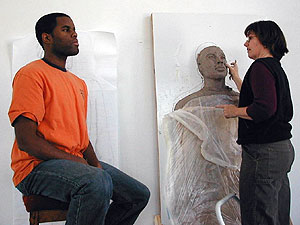|
Audio
Photos
More from MPR
Resources
Your Voice
|
Lynching victims memorial takes shape in Duluth
June 8, 2003
 |
| Delon Grant posing while artist Carla Stetson does finecarving work on the figure for the memorial. (MPR photo/Bob Kelleher) |
Duluth, Minn. — Clay takes human form in a sun drenched west Duluth studio. Carla Stetson has spent much of the last year turning fist fulls of damp clay into the images of men.
 | |||
"I make the sculptures out of clay," Stetson explains. "I make a silicone cast and plaster mother mold from the clay. We paint wax in here until it's about a quarter inch thick."
Eventually, the clay figures become bronze, cast in the time honored lost wax method.
Elmer Jackson, Elias Clayton, and Isaac McGhie were black circus workers. When the circus visited Duluth in 1920, the three were accused of rape. Historians say they were almost certainly innocent of the crime. Yet Jackson, Clayton and McGhie died for it on a June night. They were dragged from jail by a mob, beaten, tied, and hanged from a downtown light pole. There's a famous photo of grinning men and boys posing proud by limp bodies.
That's not the image in Duluth's new memorial.
 | |||
In the artist's hands, the clay has become three young men, dressed in their 1920's Sunday best, posed as if for a family photograph.
The memorial is a joint project of St Paul writer Anthony Peyton-Porter and Duluth artist Carla Stetson. Stetson says it's important to remember the victims had names.
"But, when the young men were lynched, they were depersonalized," she says. "The idea of them being individual people with real feelings and their life in front of them - all of that was taken away. And so I felt like I had to reinvest these sculptures with personalities that were obviously individual people and really very realistic. Real people," says Stetson.
Three Duluth residents were chosen to represent Clayton, Jackson, and McGhie. College student Delon Grant sees his own face emerge from clay.
 | |||
"I think it's really, really cool." Grant says. "Like how she actually can actually create my face out of the clay is really, really amazing. Like, looking at the drawing that she drew, it's really realistic. It looks like me a lot," he says.
Grant is impressed how the community has come together to make the memorial come alive.
"It's a tremendous honor to be models for something that was so big in our town," Grant explains. "Something that has become so big as making a memorial and putting something up in remembrance of these men."
There are those who'd would rather let the murders vanish with time. Bob Grytdahl, who just retired from the Duluth Police force, isn't one of them.
"What is it we're trying to forget?" Grytdahl asks. "If you want to forget the lynching and don't want to talk about that, when then let's talk about today. We saw what our community did to affect the future of three young black men in 1920," says Grytdahl. "How's our community doing today? And what are we doing today to impact the future of young black men in Duluth today?"
It's important to remember the past to prepare for the future. So says Henry Banks, a member of the committee and a driving force behind memorial's creation.
"If we fail to acknowledge this, if we fail to take ownership of it in our community, I believe that we are saying to a segment of our community, 'we don't care about you,'" Banks says. "But, if we acknowledge it, do something about it, reconcile from it, heal from it, we can all be better as a community."
 | |||
The committee broke ground for the memorial in May, almost 83 years after the lynching. A small crowd gathered among broken bricks and glass, to turn the first shovel-fulls of dirt.
The small park will fill a downtown corner, on First Street, a block up the hill from Superior street, and right across from where the men were killed. The first pieces of a memorial wall should be in place by July. Trees and benches will invite people in. In the wall, the words of Martin Luther King Jr., Gandhi, Elie Wiesel and others. For the wall's centerpiece, seven foot high images - young men - well dressed - proud.
|
News Headlines
|
Related Subjects
|
